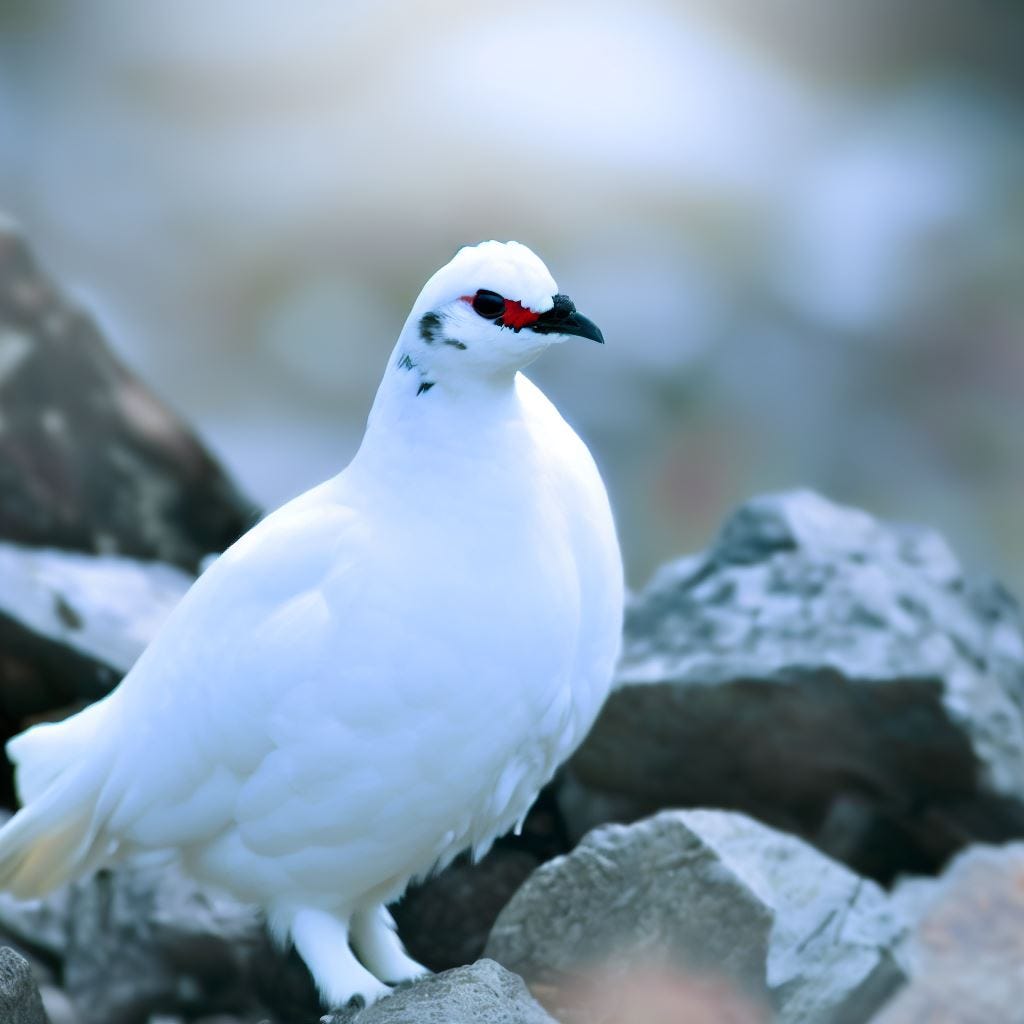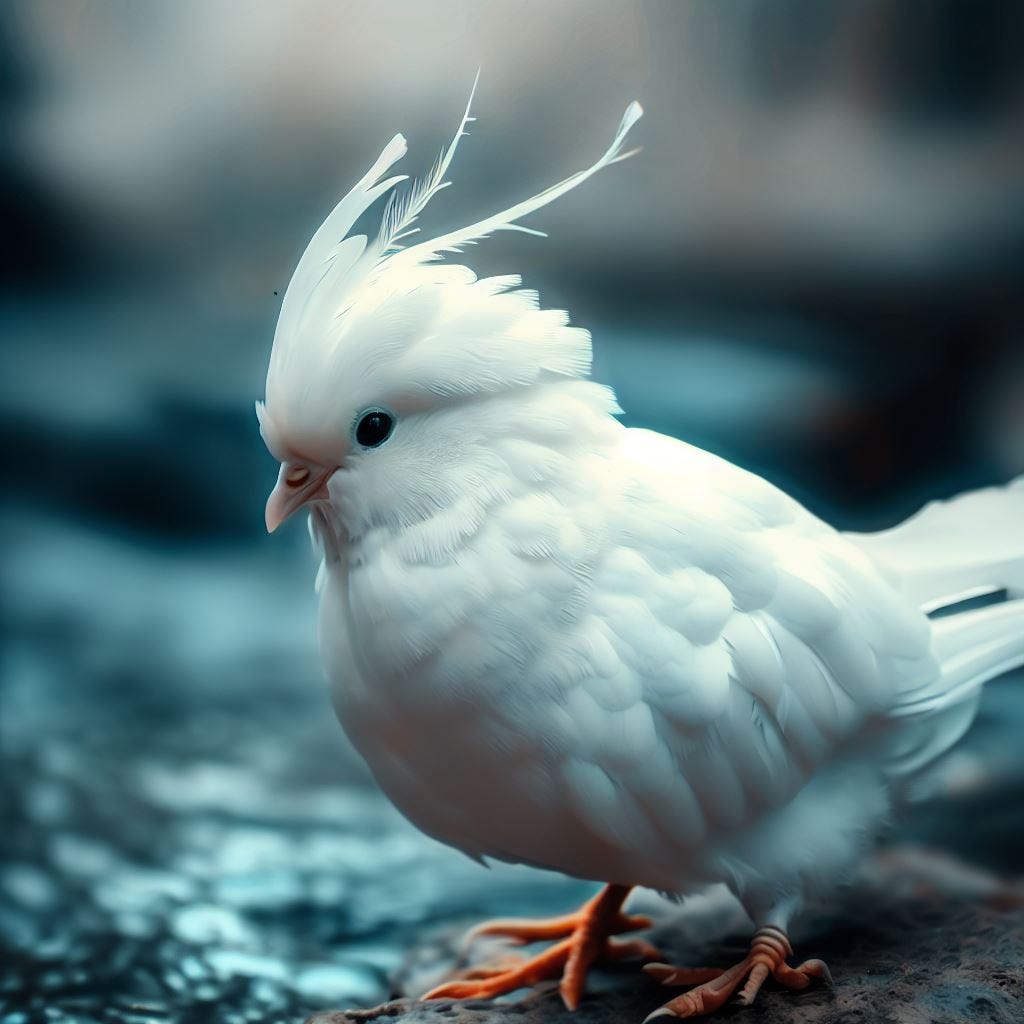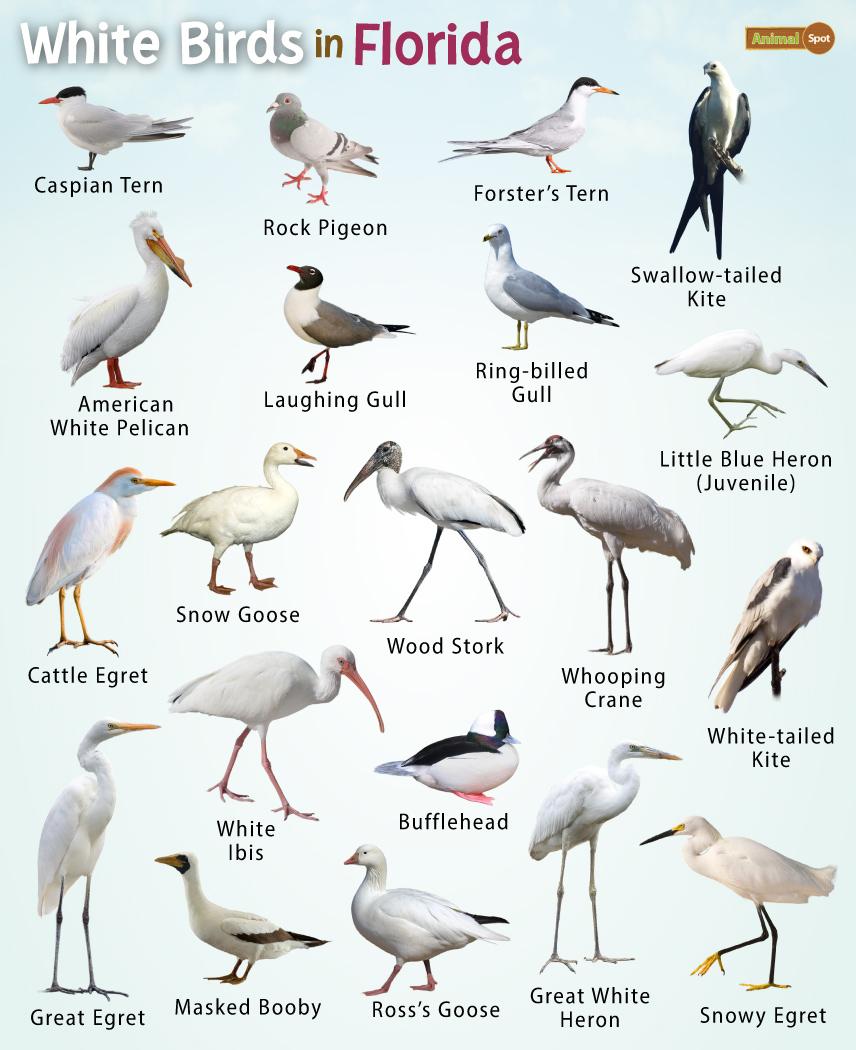White birds can refer to a variety of bird species that have predominantly white plumage. Some common examples include snowy owls, great egrets, American white pelicans, and trumpeter swans.
White birds often symbolize innocence and purity, and their pristine feathers can inspire a sense of inner peace and calmness. While some white birds can be easily distinguished from one another, others may require more careful observation to tell apart.
Understanding the unique characteristics and behaviors of each species can help birdwatchers identify these beautiful creatures in the wild.

Credit: medium.com
Table of Contents
ToggleMajestic Flight: The Snowy Owl
The Snowy Owl is a stunning bird species known for its exquisite white plumage and long, thin legs. These magnificent creatures are revered for their majestic flight and are a sight to behold in their natural habitat.
Habitat And Migration Patterns
Snowy Owls are native to the Arctic regions of North America and Eurasia, where they are perfectly adapted to thrive in the harsh, snowy landscapes. During the breeding season, they can be found in open tundra areas, often near bodies of water where they hunt for food. In the winter, these owls migrate southward in search of food, with some individuals traveling as far as the northern United States.
Diet And Hunting Techniques
The Snowy Owl primarily preys on small mammals such as lemmings, voles, and rabbits. Their exceptional hunting skills and keen eyesight enable them to locate and capture their prey with remarkable precision. These owls are known for their patient and strategic hunting techniques, often perching and scanning the surroundings before making their move.
Grace In Motion: The Great Egret
The Great Egret, also known as the Snowy Egret (Egretta thula), is a stunning bird species distinguished by its exquisite white plumage and long, thin legs. Its graceful movements and majestic appearance make it a captivating sight in wetland habitats.
Breeding And Nesting Behaviors
The Great Egret exhibits fascinating breeding and nesting behaviors. During the breeding season, they form colonies in trees, marshes, and other wetland areas. These colonies, known as rookeries, serve as communal nesting sites where multiple pairs of egrets build their nests close to one another. The nests are typically constructed from sticks, reeds, and other vegetation, providing a secure environment for their eggs and young chicks.
Significance In Wetland Ecosystems
The Great Egret plays a crucial role in wetland ecosystems. As a top predator, it helps regulate the populations of fish, amphibians, and small mammals, contributing to the overall balance of the ecosystem. Additionally, their foraging behavior helps control insect populations, thereby influencing the ecological dynamics of wetland habitats.
Gentle Giants: American White Pelicans
American White Pelicans, also known as Pelecanus erythrorhynchos, are majestic birds that captivate with their large size and graceful appearance. These gentle giants are a common sight in North America, particularly in the central and western regions of the continent. In this section, we will explore the social structure and flocking behavior of American White Pelicans, as well as their feeding habits and conservation status.
Social Structure And Flocking
American White Pelicans are highly social birds that exhibit a fascinating social structure. They form colonies, often consisting of several hundred individuals, which can be found on islands or secluded areas near lakes, rivers, and coastal regions. Within these colonies, pelicans establish a hierarchical structure, with dominant individuals having priority access to resources such as nesting sites and feeding areas.
The flocking behavior of American White Pelicans is truly a sight to behold. These birds engage in synchronized flight patterns, soaring gracefully in unison, forming V-shaped formations. This flying formation not only allows for efficient aerodynamics but also helps with navigation during long-distance migrations. By flying together, they can conserve energy and maintain communication within the flock.
Feeding Habits And Conservation Status
American White Pelicans are primarily piscivorous, meaning they primarily feed on fish. They employ a unique feeding strategy known as cooperative fishing. In shallow waters, they work together, forming a semicircle to corral fish into a concentrated area. Then, with synchronized movements, they dip their bills into the water, scooping up fish and straining out excess water with their expandable throat pouches. This cooperative feeding behavior allows them to catch a significant amount of prey in a short period.
When it comes to their conservation status, American White Pelicans are classified as a species of least concern by the International Union for Conservation of Nature (IUCN). However, they face several threats, including habitat loss, disturbance at nesting sites, and pollution. Efforts are being made to protect their breeding grounds and educate the public about the importance of preserving these magnificent birds and their habitats.

Credit: medium.com
The Trumpeter’s Call: The Swan’s Tale
White birds have always captivated the human imagination, and one such majestic creature that has left an indelible mark is the Trumpeter Swan. Let’s delve into the fascinating tale of this iconic bird, exploring its life cycle, mating rituals, and the dedicated efforts to reintroduce this species into the wild.
Life Cycle And Mating Rituals
The life cycle of the Trumpeter Swan is a testament to the marvels of nature. From the moment they hatch as adorable cygnets to their graceful maturation into majestic swans, every stage is a spectacle to behold. These birds engage in elaborate courtship rituals, where their synchronized movements and haunting calls symbolize the eternal bond of love.
Trumpeter Swan Reintroduction Efforts
The Trumpeter Swan’s tale is not without its challenges. Due to habitat loss and overhunting, their population dwindled to precarious levels. However, conservationists and wildlife enthusiasts rallied together to launch ambitious reintroduction programs. Through meticulous breeding initiatives and habitat restoration, these efforts have kindled hope for the resurgence of this iconic species.
Herons: The Stealthy Hunters
Herons, the stealthy hunters, are a type of white bird known for their exceptional hunting skills. With their long legs and sharp beaks, herons patiently stalk their prey in the water, making them expert fishermen in the avian world.
Adaptations For Fishing
Herons are expert anglers that have adapted to hunt in various aquatic habitats, from shallow ponds to rushing rivers. They have long, sharp beaks that they use to spear their prey, and their necks can extend to reach deep into the water. Additionally, their long legs and webbed feet enable them to wade in water without creating a disturbance, and they can even swim if necessary.Variations Among Heron Species
There are many different species of herons, each with its own unique characteristics. For example, the Great Blue Heron is the largest heron in North America, standing up to four feet tall with a wingspan of over six feet. The Black-crowned Night Heron, on the other hand, is a smaller bird that is active at night, using its keen eyesight to hunt in the dark. Other heron species include the Yellow-crowned Night Heron, the Green Heron, and the Little Blue Heron, each with its own distinctive appearance and behavior. Overall, herons are fascinating birds that have evolved to become expert hunters in aquatic environments. Their stealthy nature and unique adaptations make them a true wonder of the avian world.Silent Grace: The Mute Swan
Silent Grace: The Mute Swan is a beautiful white bird that captivates with its elegance and tranquility. With its mute call and graceful movements, the Mute Swan is a symbol of serenity and purity in the avian world.
Mute swans, also known as Cygnus olor, are majestic birds known for their silent grace and beauty. They are one of the largest waterfowl species, with males reaching up to 25 pounds and females up to 20 pounds. These birds are easily recognizable with their all-white plumage and long, graceful necks.Territorial Behavior And Aggression
Mute swans are known for their territorial behavior and aggression towards other birds and humans. During breeding season, they become extremely territorial and will attack other birds that come too close to their nesting area. They have been known to attack kayakers and other watercraft, making them a potential danger for recreational activities.Impact On Local Fauna And Flora
Mute swans can have a significant impact on local fauna and flora. They are known to consume large quantities of vegetation, which can lead to the destruction of aquatic ecosystems. Their aggressive behavior towards other waterfowl can also disrupt local bird populations. In some areas, the overpopulation of mute swans has become a problem, leading to controversial culling programs to control their numbers. In conclusion, while mute swans are undoubtedly beautiful creatures, their territorial behavior and impact on local fauna and flora make them a complex and sometimes problematic species. It is important to appreciate their silent grace from a safe distance and to maintain a healthy balance in our local ecosystems.Dainty Dancer: The Snowy Egret
The Snowy Egret, also known as Dainty Dancer, is a beautiful white bird with long, thin legs. Its exquisite white plumage distinguishes it from other white birds.
The Snowy Egret, also known by its scientific name Egretta thula, is a striking bird species characterized by its exquisite white plumage and slender, graceful appearance. This elegant wader is often spotted delicately wading through shallow waters in search of prey, earning it the title of “Dainty Dancer” in the avian world.Plumage And Breeding Plumage Display
The Snowy Egret is adorned with lacy plumes, particularly during the breeding season. These ethereal feathers extend beyond the bird’s body, creating an enchanting display as the egret gracefully moves through its environment. During breeding, the Snowy Egret’s plumage becomes even more resplendent, featuring vivid hues that enhance its allure and elegance.The Role Of The Snowy Egret In Ecosystems
As a crucial component of wetland ecosystems, the Snowy Egret plays a vital role in maintaining ecological balance. By foraging for small fish, crustaceans, and insects, it helps regulate the populations of these prey species. Additionally, the egret’s feeding behavior contributes to nutrient cycling within wetland habitats, ultimately benefiting the overall health and productivity of these ecosystems.The Ibis Identity: American White Ibis
When it comes to white birds, one species that stands out is the American White Ibis. With its distinct features and fascinating behavior, this bird captures the attention of bird enthusiasts and nature lovers alike.
Foraging Behavior And Habitat
The American White Ibis is known for its unique foraging behavior. It uses its long, curved bill to probe the soft mud in search of small aquatic creatures such as fish, frogs, and insects. This bird is often seen wading in shallow water, making it an excellent hunter in wetland habitats.
These ibises can be found in various habitats, including marshes, swamps, and coastal areas. They prefer areas with access to water, where they can find an abundant food supply. Their ability to adapt to different environments makes them a versatile and widespread species.
Cultural Significance And Symbolism
White birds, including the American White Ibis, hold cultural significance and symbolism in many societies. They are often associated with traits such as innocence, purity, and grace. Their white plumage represents untarnished beauty and serves as a reminder of the inherent goodness that exists in the world.
In some cultures, white birds are believed to bring messages from the divine or serve as spiritual guides. They are seen as symbols of hope, peace, and new beginnings. The American White Ibis, with its elegant appearance, carries these symbolic meanings and holds a special place in the hearts of those who appreciate its grace and tranquility.
Overall, the American White Ibis is a remarkable bird that captivates both nature enthusiasts and those who appreciate the cultural significance of white birds. Its foraging behavior and habitat preferences make it a fascinating species to observe, while its symbolism adds an extra layer of intrigue and meaning.
Bubulcus: The Cattle Egret
The Bubulcus, also known as the Cattle Egret, is a remarkable white bird species that belongs to the heron family. It is distinguished by its slender build, white plumage, and bright yellow or orange bill and legs. The Cattle Egret is commonly found foraging in close proximity to grazing livestock, showcasing an intriguing symbiotic relationship with these animals.
Symbiotic Relationships With Livestock
The Cattle Egret is well-known for its symbiotic relationship with livestock, particularly cattle. It can often be observed following grazing animals, such as cattle or buffalo, to feed on insects stirred up by their movement. This mutually beneficial relationship helps the egret by providing a readily available food source, while the livestock benefit from the egret’s assistance in controlling pests.
Adaptability And Range Expansion
The adaptability of the Cattle Egret is truly impressive, as it has successfully expanded its range from its native habitats in Africa and Asia to various regions across the world. This expansion has led to the bird being considered an invasive species in some areas, but its ability to thrive in diverse environments is a testament to its remarkable adaptability.

Credit: www.animalspot.net
Symbolism And Mythology: White Birds In Culture
White birds have long held significant symbolism and mythological importance in various cultures around the world. Their pure and ethereal appearance has inspired a range of beliefs and stories, often associated with concepts of purity, innocence, and spirituality.
Purity And Innocence
White birds are often symbolic of purity and innocence, their pristine feathers representing untarnished beauty and goodness. This symbolism resonates deeply with individuals seeking to reconnect with their own inner purity.
White Birds In Spiritual Beliefs And Stories
In spiritual beliefs and stories, white birds are revered for their association with purity and divine qualities. They are often depicted as messengers of spiritual beings or embodiments of peace and enlightenment.
Frequently Asked Questions
What Are Those White Birds Called?
The white birds can be confusing as there are several varieties like egrets, ibis, herons, and pelicans. Some of them look similar at first glance. However, snowy owl, great egret, American white pelican, trumpeter swan, herons, mute swan, snowy egret, and American white ibis are some of the exact white bird species.
White birds symbolize innocence and purity. Some popular white bird names include Casper, Coco, Coconut, Misty, Pearl, Snowflake, and Whitey. Tern is a white bird that looks like a seagull.
What Do White Birds Symbolize?
White birds symbolize innocence and purity, reflecting untarnished beauty and the inherent goodness within all beings. They resonate deeply with those seeking to reconnect with their inner purity. White birds include egrets, ibis, herons, pelicans, and snowy owls.
What Are Some White Bird Names?
Here are some white bird names: Casper, Coco, Coconut, Misty, Pearl, Snowflake, Whitey.
What Are The White Birds That Look Like Seagulls?
The white birds that look like seagulls are terns. Terns are slender seabirds with white, black, and grey plumage and are often mistaken for gulls. They are skinny, noisy, and have forked tails. Terns live in noisy colonies and usually nest on the ground.
Conclusion
White birds encompass a variety of species, including snowy owls, egrets, pelicans, and ibis. These elegant creatures symbolize innocence and purity, reflecting untarnished beauty. Recognizing different white bird species can be challenging, but it is possible to distinguish them based on their appearance and behavior.
Whether you spot them in nature or keep them as pets, white birds bring a sense of tranquility and grace. Appreciating their presence allows us to reconnect with our own inner purity.


